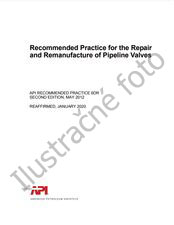Potrebujeme váš súhlas na využitie jednotlivých dát, aby sa vám okrem iného mohli ukazovať informácie týkajúce sa vašich záujmov. Súhlas udelíte kliknutím na tlačidlo „OK“.

API PUBL 800-ed.1988
Literature Survey Subsurface and Groundwater Protection Related to Petroleum Refinery Operations
NORMA vydaná dňa 1.9.1988
Informácie o norme:
Označenie normy: API PUBL 800-ed.1988
Dátum vydania normy: 1.9.1988
Kód tovaru: NS-1139906
Počet strán: 145
Približná hmotnosť: 466 g (1.03 libier)
Krajina: Americká technická norma
Kategória: Technické normy API
Anotácia textu normy API PUBL 800-ed.1988 :
API PUBL 800, 1988 Edition, September 1988 - Literature Survey Subsurface and Groundwater Protection Related to Petroleum Refinery Operations
This report is the principal product of a study under contract to the American Petroleum Institute (API) to prepare the background basis for development of a series of monographs on subsurface and groundwater protection at petroleum refineries.
The study was designed to determine by a literature search what information has been published relating to the impact of petroleum refinery operations on subsurface soils and on groundwater with special reference to potential contamination problems. The study addresses this overall objective in the following phases:
- 1. Conducting a detailed literature search for existing publications, reports, papers, etc. that address specific topics enumerated in the initial outline prepared by the API (Table 1).
- 2. Preparation of an annotated bibliography for each pertinent literature citation based upon a review of the publications.
- 3. Supplying copies of the literature cited in the annotated bibliography.
- 4. Identifying topics for which no literature could be found and additional topics identified during the study for which literature is available and which are pertinent to refinery groundwater and subsurface soil considerations.
In accordance with the objectives of the study, this report contains: (1) an explanation of how the literature search was conducted, (2) annotations for pertinent articles, (3) a list of references including articles annotated and articles reviewed but not annotated, (4) a discussion of applicable Federal Statutes and Regulations, and annotations for pertinent regulatory programs under the five principal statutes that apply to petroleum refinery operations, and (5) a discussion of elements of the Refinery Groundwater and Subsurface Outline for which few or no references were found.
With respect to Item 4, the principal area in which the literature is notably deficient is low toxicity inorganic wastes produced at refineries. Other than textbook and manual coverages, the literature search yielded few references to common refinery contaminants of low toxicity, such as sulphides, chloride, phenols and nitrogen compounds, and spent acids and alkalis. Although these compounds make up the bulk of potential pollutants from refineries, they are handled routinely in wastewater treatment systems and are not generally perceived by the public or regulators as posing severe problems requiring remediation. This tolerant perception is likely to change, however, especially with respect to phenol compounds. Phenol, for example, is classed a hazardous chemical and was included in the list of priority pollutants under Section 110 of SARA (Superfund Amendments and Reauthorization Act), which may require regulation under the Safe Drinking Water Act. The federal water qualify criteria for carcinogenic risk at the 10-5 level is 3.5 ug/l for phenol. Furthermore, at least 23 states include phenol in Water Quality Standards or Criteria for protection of aquatic life.
Liquid effluents generally are treated by physical separation of oily components, chemical flocculation, and biological treatment (including biooxidation, trickling filters, or activated sludge treatment). The cleaned water, containing dissolved inorganic matter generally is discharged to surface waters, leaving a residue of organic and inorganic sludge consisting of mineral particles, recalcitrant organic compounds, and metals (mainly chromium, lead, and zinc). The sludge is commonly disposed of by land farming, which allows further biodegradation of recalcitrant organics including polynuclear aromatic hydrocarbons (PAHs).
Solid refinery wastes comprise a wide range of materials in addition to sludges, including spent metal catalysts, treatment clays, filter cake, ash, silt, etc. Some of these materials, such as spent metal catalysts, have value and, therefore, are recycled. However, most other solids have little salvage value, and if nonhazardous are disposed of mainly as landfill.
Information on the treatment and disposal of inorganic liquid and solid waste is scattered throughout the sanitary engineering literature and commonly is not identified as refinery or petroleum industry waste. Searching the literature for references only indirectly applicable to impacts of petroleum refining on groundwater would not be cost-effective in view of the ready availability of information on industrial waste treatment in textbooks and manuals.
Odporúčame:
Aktualizácia technických noriem
Chcete mať istotu, že používate len platné technické normy?
Ponúkame Vám riešenie, ktoré Vám zaistí mesačný prehľad o aktuálnosti noriem, ktoré používate.
Chcete vedieť viac informácií ? Pozrite sa na túto stránku.



 Cookies
Cookies
